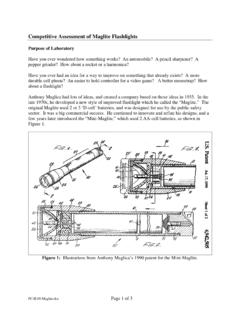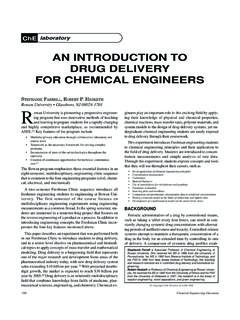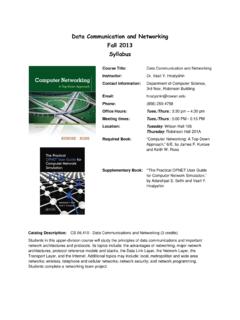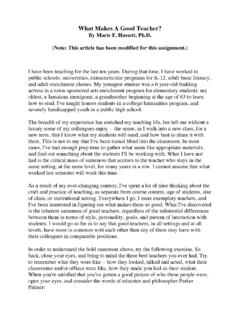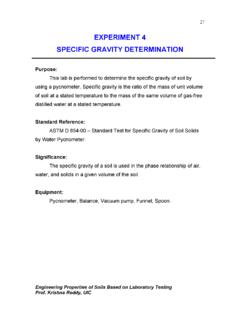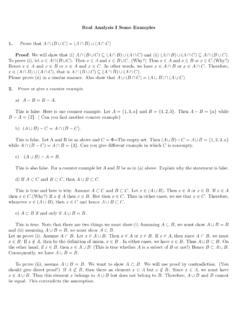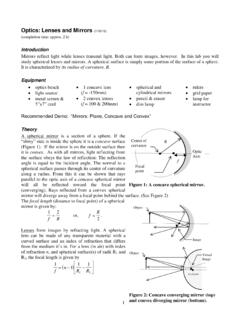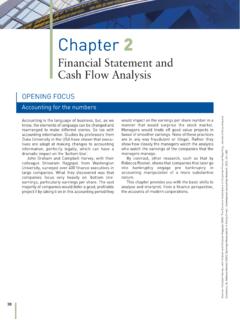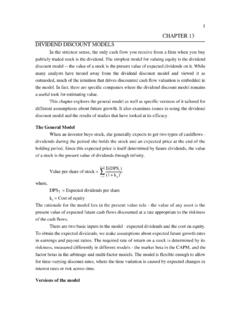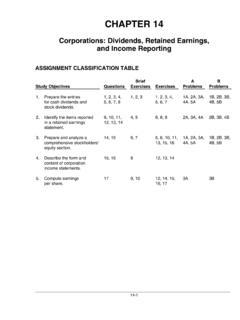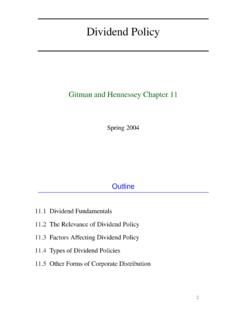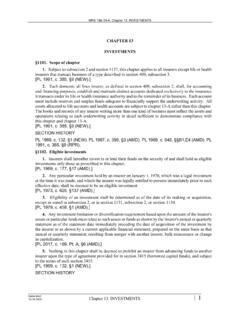Transcription of Solutions to Problems - Rowan University
1 Solutions to Problems P12-1. LG 1: dividend payment procedures Basic a. Debit Credit Retained earnings (Dr.) $330,000 Dividends payable (Cr.) $330,000b. Ex dividend date is Thursday, July 6. c. Cash $170,000 Dividends payable $ 0 Retained earnings $2,170,000d. The dividend payment will result in a decrease in total assets equal to the amount of the payment. e. Notwithstanding general market fluctuations, the stock price would be expected to drop by the amount of the declared dividend on the ex dividend date. P12-2. LG 1: Personal finance: dividend payment Intermediate a. Friday, May 7 b. Monday, May 10 c. The price of the stock should drop by the amount of the dividend ($ ).
2 D. She would be better off buying the stock at $35 and taking the dividend . Her $ dividend would be taxed at the maximum rate of 15% and her $4 short-term capital gain would be taxed at you ordinary marginal tax rate, which is probably higher than the 15%. If she bought the stock post dividend for $ she would pay her marginal ordinary tax rate on the full $ of short-term capital gains. P12-3. LG 2: Residual dividend policy Intermediate a. Residual dividend policy means that the firm will consider its investment opportunities first. If after meeting these requirements there are funds left, the firm will pay the residual out in the form of dividends. Thus, if the firm has excellent investment opportunities, the dividend will be smaller than if investment opportunities are limited. b. Proposed Capital budget $2,000,000 $3,000,000 $4,000,000 Debt portion (40%) 800,000 1,200,000 1,600,000 Equity portion (60%) 1,200,000 1,800,000 2,400,000 Available retained earnings $2,000,000 $2,000,000 $2,000,000 dividend 800,000 200,000 0 dividend payout ratio 40% 10% 0%c.
3 The amount of dividends paid is reduced as capital expenditures increase. Thus, if the firm chooses larger capital investments, dividend payments will be smaller or nonexistent. chapter 12 dividend policy 243 P12-4. LG 3: dividend constraints Intermediate a. Maximum dividend : $1, 900, 000$ per share400, 000= b. Largest dividend without borrowing: $160,000$ per share400,000= c. In Part (a), cash and retained earnings each decrease by $1,900,000. In Part (b), cash and retained earnings each decrease by $160,000. d. Retained earnings (and hence stockholders equity) decrease by $80,000. P12-5. LG 3: dividend payment procedures Intermediate a. Maximum dividend : $40, 000$ per share25,000= b. A $20,000 decrease in cash and retained earnings is the result of a $ per share dividend . c. Cash is the key constraint, because a firm cannot pay out more in dividends than it has in cash, unless it borrows.
4 P12-6. LG 4: Alternative dividend policies Intermediate Year dividend Year Dividenda. 2000 $ 2005 $ 2001 2006 2002 2007 2003 2008 2004 2009 b. 2000 $ 2005 $ 2001 2006 2002 2007 2003 2008 2004 2009 c. 2000 $ 2005 $ 2001 2006 2002 2007 2003 2008 2004 2009 244 Gitman Principles of Managerial Finance, Brief Fifth Edition d.
5 With a constant-payout policy , if the firm s earnings drop or a loss occurs the dividends will be low or nonexistent. A regular dividend or a low-regular-and-extra dividend policy reduces owner uncertainty by paying relatively fixed and continuous dividends. P12-7. LG 4: Alternative dividend policies Challenge Year dividend Year Dividenda. 2002 $ 2006 $ 2003 2007 2004 2008 2005 2009 b. 2002 $ 2006 $ 2003 2007 2004 2008 2005 2009 c. 2002 $ 2006 $ 2003 2007 2004 2008 2005 2009 2002 $ 2006 $ 2003 2007 2004 2008 2005 2009 e.
6 Part (a) uses a constant-payout-ratio dividend policy , which will yield low or no dividends if earnings decline or a loss occurs. Part (b) uses a regular dividend policy , which minimizes the owners uncertainty of earnings. Part (c) uses a low-regular-and-extra dividend policy , giving investors a stable income which is necessary to build confidence in the firm. Part (d) still provides the stability of Parts (b) and (c) and provides an extra $ per year. chapter 12 dividend policy 245 P12-8. LG 5: Stock dividend firm Intermediate (a) 5% Stock dividend (b) (1) 10% Stock dividend (b) (2) 20% Stock dividend Preferred stock $100,000 $100,000 $100,000 Common stock (xx,xxx shares par) 21,0001 22,0002 24,0003 Paid-in capital in excess of par 294,000 308,000 336,000 Retained earnings 85,000 70,000 40,000 Stockholders equity $500,000 $500,000 $500,000 110,500 shares 211,000 shares 312,000 shares c.
7 Stockholders equity has not changed. Funds have only been redistributed between the stockholders equity accounts. P12-9. LG 5: Cash versus stock dividend Intermediate a. Cash dividend $ $ $ $ Preferred stock $ 100,000 $ 100,000 $100,000 $100,000 Common stock (400,000 shares par) 400,000 400,000 400,000 400,000 Paid-in capital in excess of par 200,000 200,000 200,000 200,000 Retained earnings 316,000 300,000 280,000 240,000 Stockholders equity $1,016,000 $1,000,000 $980,000 $940,000 b. Stock dividend 1% 5% 10% 20% Preferred stock $ 100,000 $ 100,000 $ 100,000 $ 100,000 Common stock (xxx,xxx shares par) 404,000 420,000 440,000 480,000 Paid-in capital in excess of par 212,000 260,000 320,000 440,000 Retained earnings 304,000 240,000 160,000 0 Stockholders equity $1,020,000 $1,020,000 $1,020,000 $1,020,000 246 Gitman Principles of Managerial Finance, Brief Fifth Edition c.
8 Stock dividends do not affect stockholders equity; they only redistribute retained earnings into common stock and additional paid-in capital accounts. Cash dividends cause a decrease in retained earnings and, hence, in overall stockholders equity. P12-10. LG 5: Personal finance: Stock dividend investor Intermediate a. $80,000 EPS$ , 000== b. 400 Percent ,000== c. Percent ownership after stock dividend : 440 44,000 = 1%; stock dividends maintain the same ownership percentage. They do not have a real value. d. Market price: $22 = $20 per share e. Her proportion of ownership in the firm will remain the same, and as long as the firm s earnings remain unchanged, so, too, will her total share of earnings. P12-11. LG 5: Personal finance: Stock dividend investor Challenge a. $120,000 EPS$ per share50,000== 50, 000 His proportionate ownership remains the same in each case== c.
9 $40 Market price$ $40 Market price$ The market price of the stock will drop to maintain the same proportion, since more shares are being used. d. $ $ per $ $ per e. Value of holdings: $20,000 under each plan. As long as the firm s earnings remain unchanged, his total share of earnings will be the same. f. The investor should have no preference because the only value is of a psychological nature. After a stock split or dividend , however, the stock price tends to go up faster than before. P12-12. LG 6: Stock split firm Intermediate a. CS = $1,800,000 (1,200,000 shares @ $ par) b. CS = $1,800,000 (400,000 shares @ $ par) c. CS = $1,800,000 (1,800,000 shares @ $ par) d. CS = $1,800,000 (3,600,000 shares @ $ par) e. CS = $1,800,000 (150,000 shares @ $ par) chapter 12 dividend policy 247 P12-13. LG 1: Stock splits Easy a.
10 400 4 = 1600 shares will be owned by Nathan after the split. b. $121 4 = $ per share of Apple after the 4:1 split c. Value of Apple in Nathan s portfolio = shares owned price per share $400 $121 = $48,400 value before the split 1600 $ $48,400 value after the split d. Nathan does not experience a gain or a loss and, hence, his financial conditions does not change. Nathan still owns the same percentage of all Apple shares. e. Even if there was a gain or loss attributable to the split, Nathan would not have any tax liability unless he actually sold the stock and realized that change for tax purposes. P12-14. LG 5, 6: Stock split versus stock dividend firm Challenge a. There would be a decrease in the par value of the stock from $3 to $2 per share. The shares outstanding would increase to 150,000. The common stock account would still be $300,000 (150,000 shares at $2 par).
